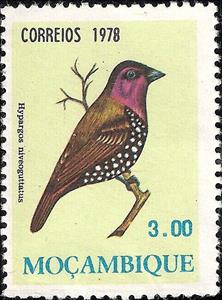Stamp: Red-throated Twinspot (Hypargos niveoguttatus) (Mozambique 1978)
Red-throated Twinspot (Hypargos niveoguttatus) (Mozambique 1978)
20 March (Mozambique ) within release Birds of Mozambique goes into circulation Stamp Red-throated Twinspot (Hypargos niveoguttatus) face value 3 Mozambican escudo
| Stamp Red-throated Twinspot (Hypargos niveoguttatus) in catalogues | |
|---|---|
| Michel: | Mi:MZ 652 |
Stamp is square format.
Birds of MozambiqueAlso in the issue Birds of Mozambique:
- Stamp - Purple-crested Turaco (Tauraco porphyreolophus) face value 0.50;
- Stamp - Lilac-breasted Roller (Coracias caudatus) face value 1;
- Stamp - Red-headed Weaver (Anaplectes rubriceps) face value 1.50;
- Stamp - Violet-backed Starling (Cinnyricinclus leucogaster) face value 2.50;
- Stamp - Red-throated Twinspot (Hypargos niveoguttatus) face value 3;
- Stamp - European Bee-eater (Merops apiaster) face value 15;
Stamp Red-throated Twinspot (Hypargos niveoguttatus) it reflects the thematic directions:
Birds (Aves), a subgroup of Reptiles, are the last living examples of Dinosaurs. They are a group of endothermic vertebrates, characterised by feathers, toothless beaked jaws, the laying of hard-shelled eggs, a high metabolic rate, a four-chambered heart, and a strong yet lightweight skeleton. Birds live worldwide and range in size from the 5 cm (2 in) bee hummingbird to the 2.75 m (9 ft) ostrich. They rank as the class of tetrapods with the most living species, at approximately ten thousand, with more than half of these being passerines, sometimes known as perching birds. Birds are the closest living relatives of crocodilians.
Animals are multicellular, eukaryotic organisms of the kingdom Animalia (also called Metazoa). All animals are motile, meaning they can move spontaneously and independently, at some point in their lives. Their body plan eventually becomes fixed as they develop, although some undergo a process of metamorphosis later on in their lives. All animals are heterotrophs: they must ingest other organisms or their products for sustenance.


